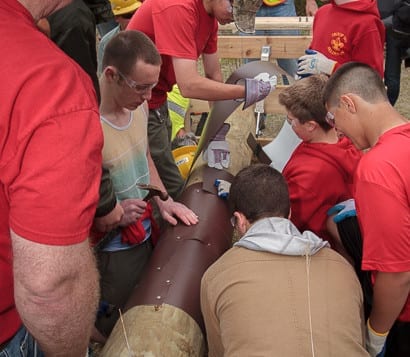By Stacy Santini
It is hard to imagine that William K. Vanderbilt II envisioned people dancing ensconced in tie dye, Frisbees being tossed into the wind, and Grateful Dead melodies connecting with the air when he donated his 43-acre Eagle’s Nest estate in Centerport to the county in 1944, but if he were at what is now known as the Vanderbilt Museum on June 7, it is pretty certain that he would marvel at the sight. Exceptional weather with crystalline blue overhead, grassy knolls kissing azure water and ornate gothic buildings served as a brilliant host to a Woodstock Revival.
The amazing world of event promoter, Rich Rivkin is a wonderland of Birkenstocks, hula hoops, live music, visual artists, bubbles, and face painters. Rivkin, who started Rich Rivkin Presents more than a decade ago, is a live art and music promotional entity. He has become a sort of pied piper for a community of people who love music, the energy and movement of festivals and fellowship. Rivkin tells us, “Look at the people around you at these events. You know that years ago they were there at those shows that the Grateful Dead and similar artists became known for — themed festivals where the audience feels a tangible sense of community as they sing the same songs in unison. I wanted to recreate that.”

Rivkin is a humble and kind soul who has made a profession out of all things altruistic. He is an environmental consultant specializing in the removal of contaminated soil and has become a national expert advisor in the field. With clients such as UPS, Rivkin’s company has more than 4,000 projects to its credit, recycling soil and bettering communities around the United States.
He is also a talented hand percussionist. Fifteen years ago he began to form drum circles so that passionate musicians like himself could collaborate with one another and share their work. Within a short period of time, popular local bands like Reckoning were eager to participate and one of Long Island’s first music festivals, called Elwoodstock, was born, overseen by Rivkin. Held at a public park in Elwood in 2001, musicians joined Rivkin for a day of music and togetherness. There were no permits in place, no insurance obtained and next to zero marketing performed, but people turned out and have been turning out ever since.
Rivkin recalls the moment he knew that these events were indeed something he not only wanted to pursue, but felt compelled to do. “It was as if we created a living room under the stars, Persian rugs and all. In the afterglow of everyone’s departure, I could still feel the vibe, the energy of the music, the sense of community. It was so personal, it actually made me cry. I had no idea in that moment how it would expand, but the seed was planted and there was no turning back.”
Known for its pristine shorelines and beaches, Long Island certainly has much to offer, but there is a movement occurring that is rapidly injecting culture into our neck of the woods and Rivkin can certainly be attributed for facilitating this local renaissance. Fusing world class musicians with local visual artists, his events have become an enclave for creators and observers alike and Rich Rivkin Presents is synonymous with both art forms. He has joined these communities together and created a fellowship much like the days of the 1960s when the Grateful Dead lyric, “Strangers stopping strangers just to shake their hands,” was the mantra. It is really quite beautiful and very much needed in such a secular society.

On Sunday, June 7, more than 50 years after the Woodstock Music Festival in upstate New York stunned a nation, the grounds of the Vanderbilt Museum were literally transformed to sustain a revival of that historical moment. Droves of hippy-clad professionals, music aficionados and art lovers alike freckled the lawns and set up camp amongst the historical landmark structures to enjoy a day of peace, love and joy. Dancing amid colorful tents, coolers and strewn blankets, attendees were treated to some of the best local music around and were able to witness the alluring process of artisans painting their canvases.
Out of the gate, the first of four bands, Jellyband, gave crowd–pleasing renditions of Grateful Dead, Creedence Clearwater Revival and Joe Cocker favorites. Lead singer Annie Mac delivered a goose bump-inducing version of Janis Joplin’s “Piece of My Heart,” elevating the energy of the crowd to eagle-soaring heights.
Germinating the vibe, Milagro took the stage next, singing and emulating Santana as only Milagro can do, bringing us favorites such as “Black Magic Woman.” A welcome addition to the familiar setlists came from the third band, Wonderous Stories, as they impeccably treated the crowd to the entire “Who’s Next” album by the incomparable beloved rock ensemble, The Who. Essentially, one voice emanated from the crowd as “Behind Blue Eyes” settled upon the audience.
Half Step, a group that has a strong following with the Long Island Deadhead community, was astounding and closed the day with an execution of “Morning Dew” that even Jerry Garcia would have loved. The vocals of Tom San Filippo and Cindy Lopez recreate the magic of the Grateful Dead in a manner very few can do. As well-known music photographers, such as Joel Werner and Artie Ralisch, and fan photographer Jason Cousins captured the crowd’s moments of rapture, it was apparent that there was no place on earth any of these people would have rather been. Festivalgoer Tom Schilling sums it up, “Breathtaking views, soul nurturing tunes, with my great friends, it is my favorite start to the season. Rivkin’s Deadfest here in September will just cap it all off.”
Rich Rivkin Presents will be indulging his friends numerous times throughout the summer with events such as Box of Rain, Long Island Sound & Art Festival and Grateful Fest. During the winter, Rivkin keeps the momentum going with indoor experiences as well. Next year, he hopes to mirror larger national festivals with a two-day camping event on a private 40-acre property on eastern Long Island. Rich Rivkin’s recipe for entertaining folks and bringing people together is marvelous, and one can only hope that he keeps playing his magical flute for years to come. For more information, please visit www.limusicfestivals.com.


















